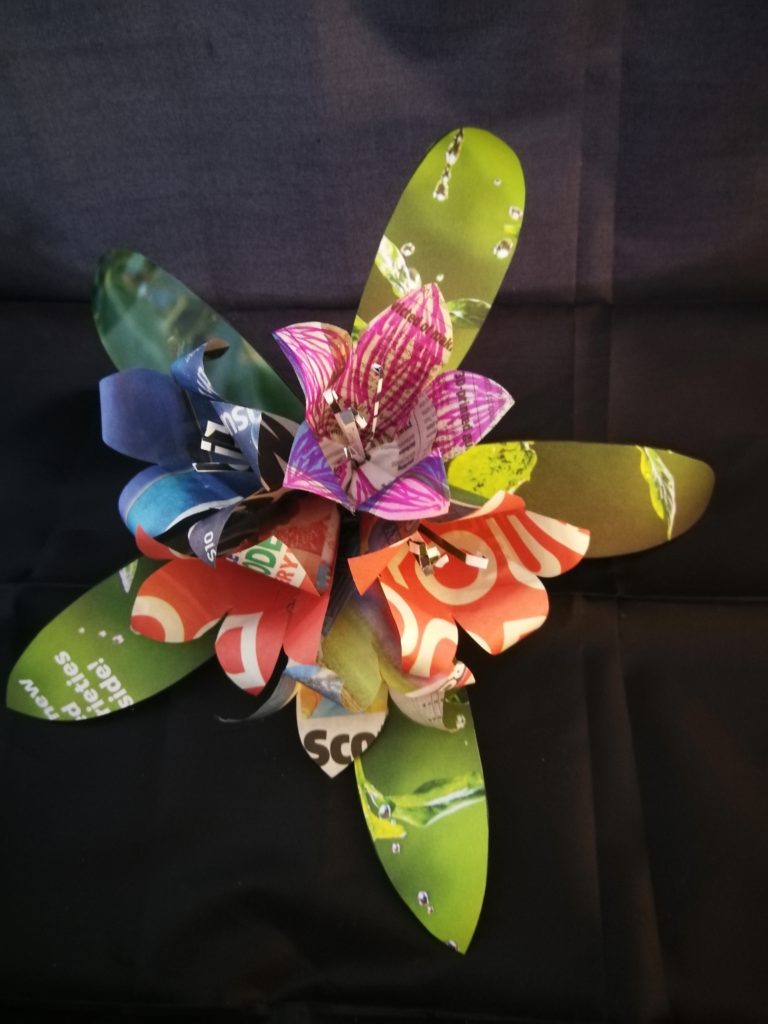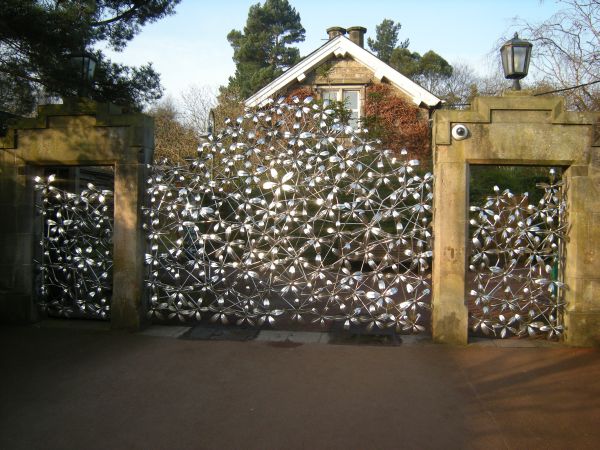On the first Friday of each month the Botanic Cottage hosts a drop-in session for those living with dementia and their family members, always with an RBGE inspired theme. With the garden currently closed due to the Covid-19 pandemic, our tutor Jaimie has created an online session this month on the theme of rhododendron, currently in bloom across the country, complete with instructions on how to craft your own paper flowers!

The fascination of Rhododendrons
While working from home like so many right now, and despite not being able to be with my lovely group at the Botanic Social this month, I’ve been able to pull together a few snippets of information for you about Rhododendrons and a wee craft activity for you, if you feel like getting creative.
However, because I’m not travelling back and forth to my studio, I’ve had to make do with what I have around the house to create this activity, and I imagine the same might be true for you!
I’ve also provided a Rhododendron colouring page for anyone that would rather create something 2D. You will need a printer for this though.
If neither of those things are options for you, I encourage to you to make this your own, experiment and play with whatever materials you have at hand. Can you paint, draw or collage? What can you create?
If you’re not feeling in the mood to make something or don’t have the materials at hand right now, perhaps you’d like to learn a little more about glorious Rhododendron, please read on.
Rhododendron, genus of woody plants in the heath family (Ericaceae).
They are notable for their attractive flowers and strong foliage. The genus is large and extremely diverse, comprising over 1000 species.
Rhododendrons are native mainly in the North Temperate Zone, especially in the moist acid soil of the Himalayas and into Southeast Asia to the mountains of New Guinea. The genus Rhododendron includes the azalea and Labrador tea.
Rhododendron means “red tree,” and refers to the red flowers and woody growth of some species, but rhododendrons range in habit from evergreen to deciduous and from low-growing ground covers to tall trees.
The first species available for garden use, in the mid-1600s, was R. hirsutum, the hairy alpine rose. This was the first Rhododendron to be classified and named.
Other Rhododendrons range from matlike dwarf species only 10 cm (4 inches) high (e.g. R. prostratum, from Yunnan, China) to trees in excess of 12 metres (e.g. R. arboreum, R. barbatum, and R. giganteum, from Asia).
Leaves are thick and leathery and are evergreen in all but the azalea species, some of which are deciduous.
Flowers may be scented or not and are usually tubular to funnel-shaped and occur in a wide range of colours—white, yellow, pink, scarlet, purple, and blue.
Botanics Stories of Rhododendron
If you have never visited the Botanics Stories blog before, it is a mine of information and it doesn’t disappoint in telling us some interesting facts about some of the Rhododendrons in the RBGE living collections. There are a few stories that I like in particular:
Nepal’s national flower

Rhododendron arboretum is the national flower of Nepal
This Rhododendon was planted at RBGE by the Nepalese Ambassador during his visit in 2010 and it’s a symbol of the long connection that our Botanic garden has with Nepal, stretching back to 1802.
You can hear more about this plant and it’s RBGE story here: https://stories.rbge.org.uk/archives/25271
Chattering of Rhodenedron
A fascinating phenomena of rhododendron in cold weather. One of the features of evergreen Rhododendrons is the ability to reduce their leaf surface, therefore reducing transpiration (the passage of water through a plant from the roots through the vascular system to the atmosphere), in cold weather.
You can hear the chattering for yourself here https://stories.rbge.org.uk/archives/7899
A legacy of plant hunters
One highly noteable plant hunter was Scotsman George Forrest (1873–1932)
He was born in Falkirk and became one of the most prolific collectors in the early 20th century. He travelled Australia before joining the herbarium staff at Edinburgh where he worked for two years before setting off on his Chinese assignment in 1904.
He was one of the first to realise that to succeed he needed to embrace the culture of an area and work with the local people there. On his first trip to China’s Yunnan province he got caught up in the political conflict between the Tibetans and the Chinese. War had broken out in the region and foreigners and people who had embraced the Western world were targeted. George and his team of 17 local people were attacked. He was the only person to survive. He managed to escape by fleeing into the jungle and was saved by a tribal chief after narrowly avoiding starvation. Remarkably, he carried on with the expedition and was to return to the region another five times.
His Chinese journeys spanned 28 years and it is believed that he collected around 1,200 plant species that were new to science, including many of our favourite rhododendrons, countless primulas, camellias, magnolias, lilies, gentians, Himalayan poppies and several types of buddleias
He was able to exploit the craze for rhododendrons that swept Western horticulture at this time and his impact was vast across Western horticulture.
Having diced with danger on many of his expeditions, as well as surviving malaria, he died of a heart attack on the last of his journeys in 1932. He was buried at Tengyueh (now Tengchong), where he was often based when carrying out his plant collecting and research. On this last expedition alone he amassed at least 300lb of seed which represented 400-500 species.
Forrest’s Rhododendron Giant
There is one specimen George Forrest brought back to Edinburgh that is very unusual, a giant in fact, Rhododendron protistum.
You can read more about his discovery and the RBGE herbarium specimen here https://stories.rbge.org.uk/archives/14186
Mixed feelings
Today we have a love/hate relationship with Rhododendrons.
We celebrate, protect from endangerment and dedicate festivals to it, for example, The Scottish Rhododendron festival that happens each spring across a number of public gardens, and yet some set out to battle its encroachment in our countryside, from where some are keen to banish it completely.
The species in the firing line of this eradication isRhododendron ponticum as it is now an established non-native invasive species within the UK, and threatens a variety of natural and semi-natural habitats and the associated flora and fauna.
R. ponticum was first introduced to the UK via Gibraltar in 1763 and by 1893 it was being sold on London markets as a flowering pot plant.
Learning from Rhododendrons at RBGE
Rhododendrons are a fair sight at the Botanics in at this time of year, with their riot of colour first on the plants themselves and then as they cast their ‘fairy outfits’- as I like to think of them- to the ground to create a dense carpet of vibrant petals.
Our intrepid plant hunter, George Forrest, is responsible for around 300 herbarium specimens of Rhododendron that are housed in at the RBGE herbarium today.
RBGE has been a major centre for rhododendron research since the late 19th century. Together, the collections in our four Gardens – Edinburgh, Benmore, Dawyck and Logan – comprise one of the world’s richest assemblage of species rhododendrons. Around half of all the 1,000 known species are cultivated in the Gardens and include most of the temperate species and over one-third of those known in the tropics.
Around one-third of all rhododendrons, over 300 species, belong to the subgenus Vireya. RBGE has the largest cultivated collection of Vireya rhododendrons in the world. As natives of the mountains of South East Asia, most like a cool, moist, frost-free evironment. These plants thrive indoors in the Montane Tropics Glasshouse.
Phenology and Rhododendrons
Phenology is the study of seasonal changes in plants and animals from year to year, such as flowering of plants, emergence of insects and migration of birds, especially their timing and relationship with weather and climate.
The phenologists of the RBGE pay close attention to the Rhododendron as part of the Rhododendron Phenology research project, observing how Rhododenrons act as a barometer of the seasons and the climate as it shifts.
Each week since April 2007, members of the Rhododendron Phenology Team (all volunteers) have followed a set route around the Inverleith site, observing 157 accessions (samples) that represent 57 species. The monitoring focusses on first and peak flowering dates, leaf development and fruiting. Daily RBGE meteorological observations made on site are used in conjunction with the team’s observations to investigate the potential effects of climate change on rhododendron phenology.
A shining example of Rhododendron
Rhododendron are so important to RBGE that there is even a piece of art dedicated to them, and if you’ve ever entered the gardens through the East Gate you’ll know exactly what I mean.

The Rhododendron gate or more accurately ‘ Hammered Steel, Reflected Glory’ created by the workshop of blacksmith Alan Dawson. You can read a blog post here: https://stories.rbge.org.uk/archives/8691
And finally…
A poem by Ralph Waldo Emerson
The Rhodora: On Being Asked, Whence Is the Flower?
In May, when sea-winds pierced our solitudes,
I found the fresh Rhodora in the woods,
Spreading its leafless blooms in a damp nook,
To please the desert and the sluggish brook.
The purple petals, fallen in the pool,
Made the black water with their beauty gay;
Here might the red-bird come his plumes to cool,
And court the flower that cheapens his array.
Rhodora! if the sages ask thee why
This charm is wasted on the earth and sky,
Tell them, dear, that if eyes were made for seeing,
Then Beauty is its own excuse for being:
Why thou wert there, O rival of the rose!
I never thought to ask, I never knew:
But, in my simple ignorance, suppose
The self same Power that brought me there brought you.
Our Garden Socials at the Botanic Cottage are kindly supported by players of the People’s Postcode Lottery.
